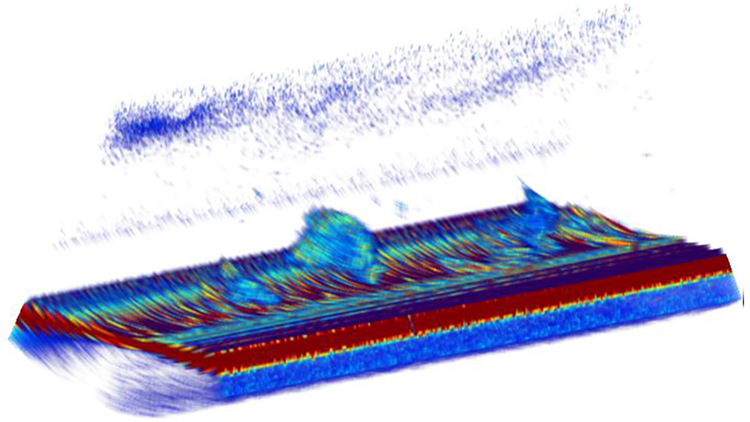Features and functionality
The Simrad ME70 offers quantitative data and high operational flexibility.
The Simrad ME70 provides an adjustable wide fan of stabilized and calibrated beams for biomass estimation, fish school characterization and behaviour studies. All beams can be configured as split beams providing data for single target analysis, such as target strength measurements and target tracking. The sector of calibrated narrow split beams with low sidelobe levels and short pulse lengths allow for accurate biomass estimation very close to the bottom. The ability to adjust the athwartship centre angle of the fan enables you to use the system for studying fish close to ridges and slopes. The design also permits you to use all the beams over the full frequency range pointing in one direction for frequency comparison.

Using a suitable post-processing application with data provided by the Simrad ME70 scientific multibeam systems, you can observe both schools of fish as well as single fishes in 3D.
Not just an ordinary multibeam sounder
Within the bandwidth of the transducer, the limits for beam steering, and the minimum achievable beam opening, you can select the directions, frequencies, and opening angles for the beams in the Simrad ME70. You will be able to configure the system to fit your requirements, and the system will provide you with a real-time display for quality control of the current data acquisition. The system configuration can be tailored to any user requirements, allowing for choice of beamwidths as well as transmission modes.
Low sidelobe levels and beam interleakage
Low sidelobes are important for two reasons. The obvious one is to avoid that strong targets in the sidelobes are mistaken for weak targets in the main lobe. Secondly, you do not want to see strong bottom echoes from the sidelobes. Even the vertical receiver beam may benefit from low sidelobes in case of a sloping bottom. Very low two-way sidelobe levels are obtained by using two-way side lobe suppression. Very low beam interleakage is obtained by using Frequency Rotated Directional Transmission (FRDT) where the frequency band is distributed over all the beams. Since each beam has its dedicated frequency and the fan width is configurable, the design allows you to use all the beams over the full frequency range pointing in one direction for frequency analysis of targets.
Split-beam configuration
All beams can be configured as split beams. Also, two adjustable reference split beams are available. These allow you to compare ME70 data with data from other split beam systems, for example, the Simrad EK60. The reference beams can for example have 7x7 degrees opening angles, and operate on 70 and 120 kHz.The data from the individual split beams are presented in the same way as on other Simrad scientific sounders.